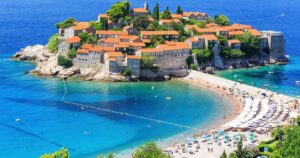
According to Serbian Economist, the island hotel Sveti Stefan near Budva, which is iconic for Montenegrin tourism, may resume operations by May 1, 2026, after many years of inactivity, as the Montenegrin government and the complex’s tenant, Adriatic Properties, are close to reaching an agreement on its reopening.
According to the draft agreement, existing contracts with the tenant and Aman Resorts will remain in force, the parties waive their claims in arbitration proceedings, and each party bears its own costs in London, with the exception of Adriatic Properties’ obligation to compensate Sveti Stefan Hotels for approximately £50,800 previously paid to the arbitration court.
A key element of the project is the obligation of the tenant and Aman to prepare the complex for opening no later than May 2026, with the lease term extended for another four years to compensate for the period of downtime and lost revenue.
A separate section sets out obligations to work with the local community: priority employment for residents of Budva and Paštrovici, purchasing products from local producers, regular fairs for local goods, educational and scholarship programs for young people, and year-round tours of the region. A new advisory body, tentatively called the “Bankada Council,” will be responsible for monitoring the implementation of these points and will report annually to the government. It may be headed by Serbian tennis player Novak Djokovic, which, according to Vijesti sources, will give the project additional publicity and credibility.
According to media reports, Djokovic has been acting as an informal mediator between the Montenegrin government, Aman Resorts, and Adriatic Properties in the dispute over Sveti Stefan since early 2025 and is discussing the possibility of participating in the project as an investor and representative of the Aman hotel chain.
The Sveti Stefan complex, which includes the island hotel of the same name, the Milocer villa, and the adjacent beaches, has been closed since 2021 amid a conflict between the state and the tenant over beach access and guest privacy.
Sveti Stefan is a historic fortified island village on the Adriatic coast a few kilometers from Budva, which was transformed in the mid-20th century into an elite resort where European monarchs, world politicians, and Hollywood actors vacationed over the years. In 2007, the Montenegrin government signed a 30-year lease agreement for the Sveti Stefan-Milocer complex with Adriatic Properties, a company linked to Greek businessman Petros Stathis, and operational management was transferred to Singapore-based luxury operator Aman Resorts. In 2015, the lease was extended until 2049, with the annual rent reduced to approximately €1.1 million.
https://t.me/relocationrs/1886
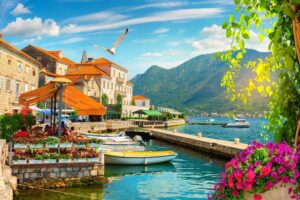
According to Serbian Economist, Serbia has once again become one of the leading foreign investors in Montenegro’s economy, ranking second in terms of direct investment in January-August 2025, behind only Turkey.
According to preliminary data from the Central Bank of Montenegro, the total inflow of foreign direct investment (FDI) for the eight months of 2025 amounted to €595.58 million, which is 3.46% more than in the same period last year. Net investment inflows reached €314.39 million, down 4.75% year-on-year.
Of this, €376.83 million (63.3% of total inflows) was accounted for by partial investments, mainly in real estate (around €308.9 million, +8.4%), while investments in companies and banks declined to less than €68 million. Approximately €197.1 million (33.1%) accounted for intercompany debt.
In terms of country structure, Turkey was the leader with €92.2 million, of which more than half accounted for intra-group debt, and approximately €35.5 million accounted for real estate purchases. Serbia came in second with €91.84 million, with Serbian investors investing around €60.9 million in real estate in Montenegro. Next came Germany (€43.5 million), the US (€41.6 million), and Cyprus (around €40 million).
The United Arab Emirates invested about €30.7 million, dividing the funds roughly equally between real estate and intercompany financing.
Russia, which was previously among Montenegro’s largest investors, has fallen to seventh place.
In terms of direct investment, Ukraine is not among the top five foreign investors in Montenegro, but Ukraine’s presence in the country’s economy is gradually expanding. According to data from Montenegro’s tax and customs authorities, in 2022 alone, Ukrainian citizens founded about 200 companies, which is about 3% of the total number of new companies created by foreigners during the year.
Earlier it was reported that against the backdrop of the war and the relocation of businesses to Montenegro, the number of Ukrainian citizens who received temporary and permanent residence permits has increased significantly, with Ukrainian companies mainly operating in the service, IT, and small business sectors.
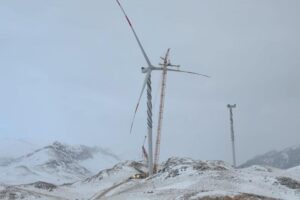
According to Serbian Economist, Montenegro’s state-owned energy company Elektroprivreda Crne Gore (EPCG) has announced the installation of Europe’s largest wind turbine at the Gvozd wind farm, which is currently under construction, marking the project’s transition to its final phase, Montenegrin media reported, citing a statement from the company.
According to EPCG, the first 7 MW wind turbine with a tower height of about 120 m and blades 85 m long has been successfully installed at the Gvozd wind farm site. The company specified that upon completion of pre-installation work and equipment delivery in the coming weeks, the accelerated installation of the remaining units will begin, followed by trial operation and final technical testing of the entire complex.
EPCG notes that the Gvoz wind farm should significantly improve the stability and reliability of Montenegro’s energy system, increase the share of renewable sources in the generation structure and further strengthen the country’s position as one of the regional leaders in green energy transformation. The project is being implemented in accordance with European technical, environmental and safety standards.
EPCG Chairman of the Board Milutin Djukanovic said that the installation of the largest wind turbine in Europe confirms Montenegro’s ability to implement projects comparable in scale and technology to the most advanced energy systems in the EU.
EPCG previously reported that upon completion, the Gvozde wind farm will generate approximately 150 GWh of electricity per year, which will cover the consumption of about 25,000 households without the use of subsidies from the state budget.
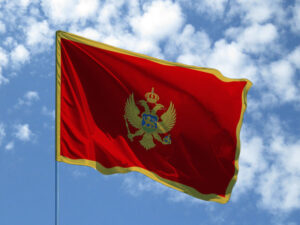
According to Serbian Economist, Montenegro will cancel visa-free entry for Russian citizens and introduce a visa regime by the end of the third quarter of 2026 as part of the harmonization of visa policy with the rules of the European Union.
“In accordance with the commitments undertaken by Montenegro on its path to full membership in the European Union, the country must fully harmonize its visa policy with the EU policy by the end of the third quarter of 2026. This includes, among other things, the introduction of a visa regime for Russian citizens,” the commentary reads.
Russian citizens can now enter Montenegro without a visa and stay in the country for up to 30 days under a bilateral agreement.
According to the national statistical service Monstat, in 2023 Montenegro was visited by about 247 thousand tourists from Russia, which provided 24% of all overnight stays of foreign guests; in 2024 their share amounted to 18.3% with a total flow of 2.6 million tourists. According to the Ministry of Internal Affairs of Montenegro, about 20 thousand citizens of the Russian Federation with temporary or permanent residence permits are officially registered in the country.
Thus, the tightening of the visa regime will potentially affect annually hundreds of thousands of tourist trips and tens of thousands of Russians living or regularly vacationing in Montenegro. Experts expect that part of this flow will be reoriented to other visa-free or easier destinations for Russians – primarily Turkey, Egypt, UAE, Serbia and a number of Asian countries.
https://t.me/relocationrs/1822
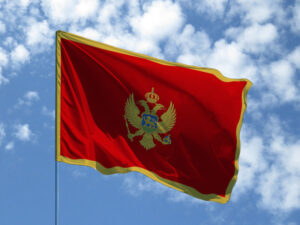
According to the Serbian Economist, Montenegro will soon tighten the visa regime for Russian citizens, bringing it in line with the rules of the European Union. This was announced by the Prime Minister of the country Milojko Spajic.
According to the head of the government, Podgorica intends to fully harmonize visa policy with the EU, which means the abolition of the current order allowing Russians to stay in Montenegro up to 30 days without a visa. Spajic emphasized that the measures will be introduced “very soon” and are part of the course to accelerate European integration and achieve EU membership by 2028.
Russian citizens can now freely enter the country for short periods of time without a visa, which has led to a significant increase in the number of tourists and re-locations from Russia in recent years. Once the regime is tightened, entry will require a visa at consular offices, similar to Schengen rules.
How many Russians now reside in Montenegro
According to official data from the Ministry of Internal Affairs of Montenegro, at the beginning of 2024-2025 in the country officially registered about 20 thousand citizens of Russia with a temporary or permanent residence permit. This makes Russians one of the most numerous foreign communities in the small 600-thousand-strong state.
In addition, according to the calculations of tourism and migration services, several thousand more Russians are in the country without long-term statuses – on tourist stay, on business grounds or in the process of registration of residence permits.
Prime Minister also recalled that Montenegro had previously tightened visa rules for citizens of Armenia, Uzbekistan, Kuwait and Egypt within the framework of adapting visa policy to EU standards. Podgorica fully follows the general foreign and defense policy of the European Union, including sanctions and visa restrictions against Russia.
Observers attribute the upcoming changes to pressure from Brussels following the tightening of the EU visa regime for Russians, as well as Montenegro’s desire to reaffirm its commitment to the European course against the backdrop of membership negotiations.
https://t.me/relocationrs/1792
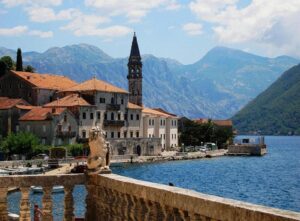
As reported by the Serbian Economist, the Government of Montenegro at a meeting of the Council of National Security approved a package of measures to tighten migration policy, including a proposal to fix in the Law on Foreigners the minimum value of real estate € 200 thousand as a basis for granting temporary residence. This is stated in the official message of the Cabinet of Ministers.
Among other decisions of the Council is the instruction to the Ministry of Foreign Affairs to prepare amendments to the decree on visa regime, which will reduce the period of visa-free stay for citizens of countries not aligned with the EU visa policy from 90 to 30 days. The Council also ordered that data on dormant and inactive foreign-owned companies be handed over to the police for verification and possible revocation of previously issued residence permits.
The government notes that the “company for the sake of a residence permit” ground is planned to be replaced by the requirement of full employment with a registered employer or an established company. At the same time, local media specify that the Parliament has introduced amendments, according to which the extension of residence permit for the founder of the company will be possible if there are at least three full-time employees, of which at least one Montenegrin citizen, and the extension of residence permit for real estate will depend on its value and size. These norms are to be detailed in bylaws.
Podgorica emphasizes that the measures are aimed at aligning the rules with EU approaches and strengthening control over migration flows. The final changes will require the adoption of amendments to the law and bylaws.
https://t.me/relocationrs/1698